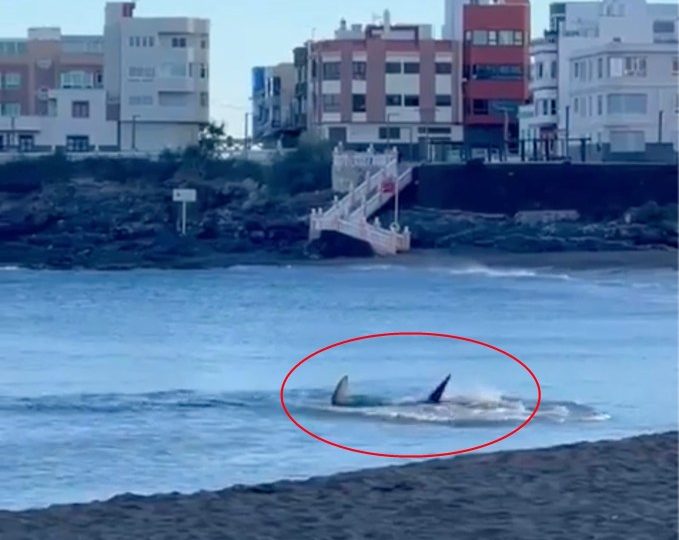THIS is the chilling moment a seven-foot shark stalked the shoreline and sent terrified tourists fleeing at a Gran Canaria beach.
Youngsters could be heard screaming as the shark‘s telltale fin was spotted sticking out of the water.
A Gran Canaria beach was closed to bathing after a seven-foot shark terrified localsSolarpix
Terrified tourists were seen fleeing from the beachSolarpix
Others, meanwhile, watched the giant fish from the shoreSolarpix
Cops raced to Melenara Beach on the island’s east coast after the alarm was sounded around 5pm on Saturday.
Lifeguards had previously helped clear the sea and the red flag was hoisted soon afterwards.
Footage from the scene showed youngsters running for safety as the shark swam towards the shoreline before turning back at the last minute after thrashing around in the water.
Another man was pictured with a child in his arms from the safety of the sand as he watched it come towards them.
A council spokesperson for Telde Council, the municipality Melenara beach comes under, said: “It’s important people stay calm and follow the instructions of the lifeguards and the authorities.”
A young girl who was in the water when the shark appeared told a local TV station: “The lifeguard started blowing his whistle and indicating everyone should get out of the water and I looked round and saw its fin.”
A friend added: “We saw the fin which was about seven inches out of the water and we began to move as fast as we could back towards the beach.”
A search for the shark in the area using jet skis failed to locate it.
It was unclear first thing this morning if the red flag would remain in place on Sunday.
Photodisc – GettyHammerhead sharks are generally not considered highly dangerous to humans[/caption]
The shark was seen thrashing around in the waterSolarpix
The shark has been identified locally as a hammerhead shark which can grow up to 20 feet in length and weigh up to 1,000 pounds, although smaller sizes are more common.
Most hammerhead species are considered harmless to humans and few attacks have been recorded, but they are aggressive hunters and their size and fierceness make them potentially harmless.
Last month tourists and locals were banned from going into the sea following a shark sighting off a Menorcan beach.
Coastguards hoisted the red flag and called the Spanish equivalent of 999 after the fin of a seven-foot blue shark or tinterora was seen above the water line.
The alarm was raised around 3.30pm on May 6 at the popular beach of Arenal d’en Castell – the same place another shark was spotted in June 2018 when swimmers were also banned from entering the water for the entire afternoon.
The shark sighting was described at the time as the first so far this year near a Costa beach.
Blue sharks rarely bite humans but have been implicated in several biting incidents, four of which are said to have ended fatally.
A blue shark was blamed for an attack on a holidaymaker in Elche near Alicante in July 2016.
The 40-year-old victim was rushed to hospital and given stitches to a wound in his hand.
First aiders described the bite as “large” and said he had come out of the sea with blood streaming from the injury.
In June last year a fully grown blue shark measuring some seven feet caused panic off the Costa Blanca beach of Aguamarina in Orihuela Costa, south of Alicante.
Bathers were filmed trying to run to safety through waist-high water as it neared the shoreline.
Lifeguards blew on their whistles to warn locals and holidaymakers about the big fish and urge them to get out of the sea as quickly as possible.
One woman, thought to have been an elderly person seen being helped out of the water by beachgoers is said to have suffered a panic attack after realising the shark was beside her.
It washed up dead the following day by rocks at La Caleta Beach in Cabo Roig a couple of miles away.
The same day it emerged the same species of shark had been spotted inside Ciutadella Port in Menorca.
Shark sightings are not common in the Balearic Islands.
Cops raced to Melenara Beach on Saturday afternoonSolarpix
What are hammerhead sharks & are they dangerous?
HAMMERHEAD sharks are a distinctive and fascinating group of sharks known for their unique hammer-shaped heads, called cephalofoils.
There are nine species of hammerhead sharks, with the most well-known being the great hammerhead, scalloped hammerhead, and smooth hammerhead.
Hammerhead sharks are generally not considered highly dangerous to humans. While they are large, powerful predators, they are not known to be aggressive toward people.
Documented attacks on humans by hammerhead sharks are extremely rare. When such incidents do occur, they are usually cases of mistaken identity or provoked situations.
Hammerheads are typically shy and avoid humans. They may show curiosity but are unlikely to display aggressive behaviour unless threatened or provoked.
Many divers and swimmers encounter hammerhead sharks without any issues. In fact, these encounters are often sought after by divers due to the sharks’ impressive appearance and the relatively low risk they pose.
Despite not being typically dangerous, caution should always be exercised around any large marine animal.









